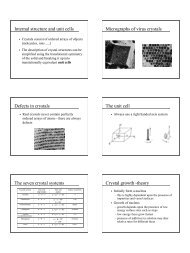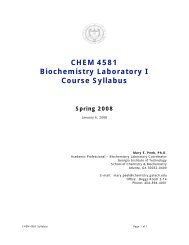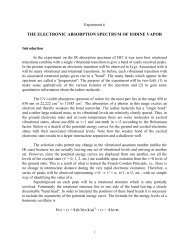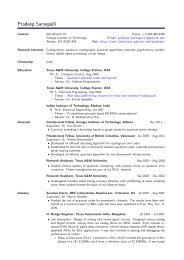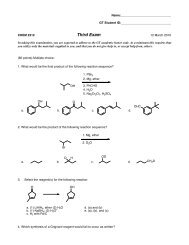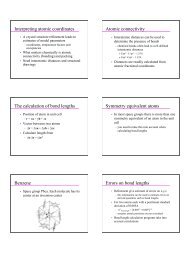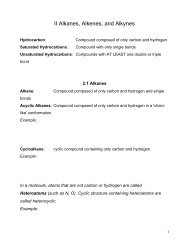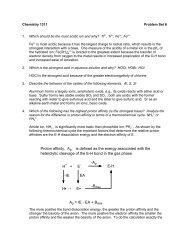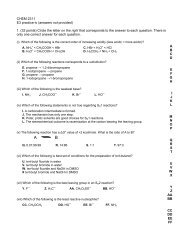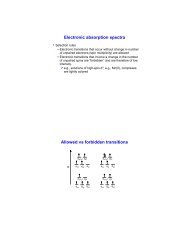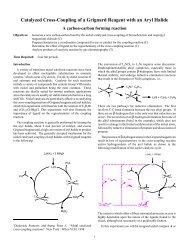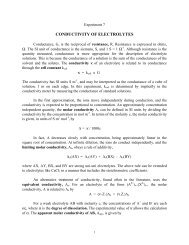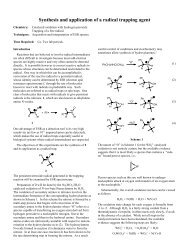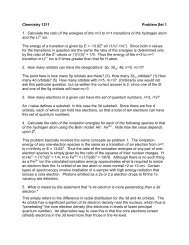You also want an ePaper? Increase the reach of your titles
YUMPU automatically turns print PDFs into web optimized ePapers that Google loves.
<strong>Covalent</strong> <strong>bonding</strong><br />
uThere are many different approaches to<br />
describing covalent bonds<br />
– which one you pick is often a compromise<br />
between ease of use and accuracy<br />
uMolecular orbital theory is the best<br />
approach if good agreement with<br />
experiment is needed<br />
Lewis theory<br />
uLewis’ theory of <strong>bonding</strong> was one one the<br />
earliest to have any success<br />
uBased on the octet rule<br />
– main group elements like to have eight<br />
electrons when they form compounds (except<br />
hydrogen)<br />
Bond order<br />
uIn many cases Lewis structures can be used<br />
to calculate bond orders that correlate well<br />
with experimentally measured bond<br />
strengths and lengths<br />
– :N:::N: triple bond<br />
– O::O double bond<br />
1
Formal charges<br />
uA molecule may have more than one<br />
plausible Lewis structure<br />
uThe best Lewis structure is the one that has<br />
the least charge separation<br />
Resonance structures<br />
uMolecules and ions with more than one<br />
distinct but equivalent (by rotation or<br />
reflection etc.) Lewis structures can occur<br />
the real structure is usually an average of<br />
these different resonance forms<br />
Failures of the Lewis model<br />
uA number of molecules with odd numbers<br />
of electrons exist (no octet) e.g. NO<br />
uAn atom may not have enough electrons to<br />
complete its octet without having ridiculous<br />
formal charges e.g. BF 3<br />
uA central atom may clearly have more than<br />
8 electrons e.g. SF 6<br />
uO 2 is paramagnetic!!<br />
2
Molecular Orbital theory<br />
uIn principle, the electronic structure of<br />
molecules can be worked out in the same<br />
way as for atoms<br />
– solve the schrodinger equation<br />
uThis gives molecular orbitals rather than<br />
atomic orbitals<br />
uHowever, it is difficult to solve the<br />
Schrodinger equation for molecular species<br />
LCAO approximation<br />
uGood approximations to the molecular<br />
orbitals can be obtained by taking linear<br />
combinations of atomic orbitals<br />
Rules for use of MOs<br />
uWhen two AOs mix to give MOs, two MOs<br />
will be produced<br />
uFor mixing AOs must have similar energies<br />
uEach orbital can have two electrons max<br />
uFill lowest energy orbitals first<br />
uIf you have unpaired electrons they should<br />
be spin parallel (Hund’s rule)<br />
uBond order is number of <strong>bonding</strong> pairs<br />
minus number of anti<strong>bonding</strong> pairs<br />
3
Period 1 diatomics<br />
Overlapping p-orbitals<br />
Oxygen and fluorine<br />
4
Nitrogen<br />
Bond orders<br />
Experimental verification<br />
uUV-photoelectron spectroscopy can be used<br />
to verify the MO diagrams.<br />
– Molecules are ionized using monochromatic<br />
light<br />
» N 2(g) + h•---> N 2<br />
+<br />
(g) + e -<br />
– The kinetic energy of the resulting<br />
photoelectrons is measured<br />
5
PES spectrum for N 2<br />
Heteronuclear diatomics<br />
uMO diagrams for heteronuclear species are<br />
constructed in a similar fashion to those for<br />
homonuclear species<br />
– However, the AO energies are different<br />
Molecular shapes<br />
uThe prediction of molecular shapes can be<br />
done in a number of ways<br />
– MO theory is very effective. However, it<br />
requires complicated calculations<br />
– VSEPR (Valence Shell Electron Pair<br />
Repulsion) theory is good for main group<br />
compounds and predictions can be made easily<br />
6
VSEPR<br />
uVSEPR does not have a solid theoretical<br />
foundation<br />
uIt is based on the idea that pairs of valence<br />
electrons (either <strong>bonding</strong> or lone pairs) will<br />
try and avoid each other as much as<br />
possible<br />
– molecule adopts a geometry that allows<br />
electron pairs to be as far apart as possible<br />
Electron pair count and geometry<br />
uTwo pairs on central atom - linear<br />
uThree pairs on central atom - trigonal<br />
uFour pairs on central atom - tetrahedral<br />
uFive pairs on central atom - trigonal<br />
bipyramidal<br />
uSix pairs on central atom - octahedral<br />
uSeven pairs - a number of possibilities<br />
Electron counting<br />
uFor molecules with single bonds to the<br />
central atom count all valence electrons of<br />
central atom plus one electron for each<br />
ligand atom<br />
– BCl 3 3 electrons from boron and 1 from each<br />
chlorine so there are 3 pairs of electrons<br />
uWhen there are double bonds present count<br />
the four electrons associated with the<br />
double bond as a single pair<br />
7
Linear geometry<br />
Trigonal geometry<br />
Tetrahedral geometry<br />
8
TBP geometry<br />
Octahedral geometry<br />
Seven coordinate species<br />
uIF 7 , XeF 6 , UF 7<br />
2-<br />
, NbF 7<br />
2-<br />
9
Species that violate VSEPR<br />
uLike nearly all truly useful sets of rules<br />
there are exceptions<br />
uSpecies that are sterically crowded often do<br />
not obey VSEPR<br />
» XeF 6 obeys VSEPR (7 pairs)<br />
» TeCl 6<br />
2-<br />
does not (7 pairs but is octahedral)<br />
Hybridization<br />
uThe <strong>bonding</strong> around atoms with different<br />
geometries is often pictures as consisting of<br />
overlapping hybrid orbitals<br />
– a hybrid orbital is a mixture of AOs<br />
– mixing in different ways gives different<br />
geometries<br />
Different types of hybridization<br />
10
How useful are hybrid orbitals<br />
uThe use of hybrid orbitals provides a<br />
picture of the <strong>bonding</strong> around an atom<br />
uHybridization arguments are not predictive,<br />
just descriptive<br />
uMO theory is predictive but complicated to<br />
use<br />
An MO view of H 2 O<br />
uMO theory predicts the lone pairs and<br />
bonds in H 2 O are not equivalent unlike the<br />
hybridization view<br />
Intermolecular forces<br />
uAttractive interactions between molecules<br />
allow the formation of molecular liquids<br />
and solids<br />
uThere are a number of different types of<br />
intermolecular forces<br />
– dispersion/London/van der Waals forces<br />
– dipolar interactions<br />
– hydrogen bonds<br />
11
Dispersion forces<br />
uAll molecular and atomic species are<br />
attracted to each other by dispersion forces<br />
uFluctuations in charge distribution polarize<br />
nearby atoms and molecules. This induced<br />
dipole interacts with the original uneven<br />
charge distribution<br />
The strength of dispersion forces<br />
uThe strength of the interaction depends on<br />
– number of electrons in atom or molecule<br />
– spatial extent of atom or molecule<br />
uIncreasing electron count tends to increase<br />
the strength of the interaction<br />
– more charge to move around<br />
uIncreasing spatial extent increase the<br />
interaction<br />
– can get better charge separation<br />
The BPs of MH 4 species<br />
12
Interactions between polar molecules<br />
uSome molecules have a permanent dipole<br />
moment<br />
– due to a low symmetry charge distribution<br />
uTo get low symmetry charge distribution<br />
you must have polar bonds<br />
– uneven distribution of charge between two<br />
bonded atoms<br />
uPolar bonds do not guarantee a polar<br />
molecule!<br />
Electronegativity<br />
uSome atoms are better at attracting<br />
electrons than others<br />
– the ability to attract electrons is called<br />
electronegativity<br />
uElectronegativity was quantified by Pauling<br />
Dipole-dipole versus dispersion<br />
uMolecular dipoles can give a significant<br />
contribution to intermolecular forces<br />
– CO (BP 82K) and N 2 (BP 77K)<br />
uHowever, dispersion forces are usually<br />
more important<br />
– HCl (BP 188K) and HBr (BP 206 K)<br />
13
The effect of hydrogen <strong>bonding</strong><br />
Hydrogen <strong>bonding</strong><br />
uVery polar molecules (HF, H 2 O, NH 3 ) often<br />
have anomalous properties<br />
uThe interactions between molecules are<br />
strong<br />
– intermolecular distances drop down into the<br />
region where a covalent contribution is to be<br />
expected<br />
14




